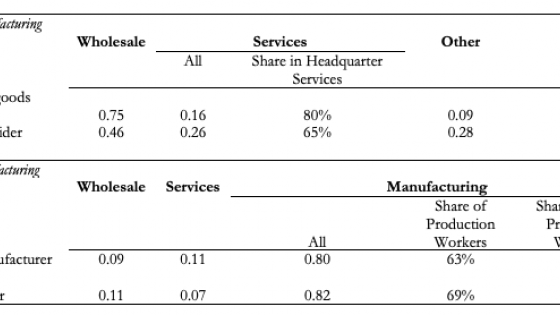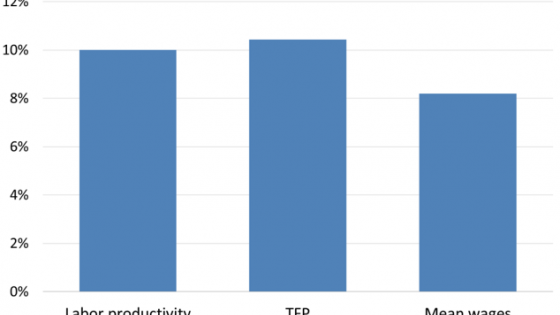The development of global value chains (GVCs) in the last decades has led to the emergence of ‘factoryless’ manufacturers (also referred as factoryless goods producers, see Kamal 2019), which have invented a new trade model – selling services of intangible assets (brands, design, patented technologies, supply chain management know-how, etc.) to international customers via tangible products assembled or made by foreign contract manufacturers. This new model differs fundamentally from conventional trade in intangible assets, because factoryless manufacturers do not license their intellectual property (IP) to third parties, and they gain returns on their IP by selling tangible products assembled/made by contract manufacturers.
The new export model has challenged the validity and appropriateness of current trade statistics for measuring value chain trade. First, factoryless manufacturers ship their products to international markets from the countries where their products are assembled or made – if not all, most of which are not their home countries. Second, factoryless manufacturers retain ownership of their products assembled/made by contract manufacturers until the products are sold. When contract manufacturers ship those products to international markets, they only declare to customs the cost of manufacturing. Hence, the value added of intangible assets embedded in those tangible goods is not recorded in the trade statistics of any country.
The popular OECD TiVA database (Sturgeon 2015) does not include the trade of intangibles via GVCs by factoryless manufacturers either. The TiVA database is constructed with current trade statistics. It simply uses international input-output tables to decompose officially reported gross trade value according to country origins, thus only covers the value added of manufacturing stages, just part of GVCs.
Missing exports of factoryless manufacturers
A few stylised facts presented in Xing (2021) unequivocally show that current trade statistics fail to record the exports of factoryless manufacturers. The most salient example of a factoryless manufacturer is Apple, which sold $51.94 billion in products in the Chinese market in 2018. However, if we were to refer to the official trade statistics, we would conclude that Apple did not even export $1 in products to China. According to the UN Comtrade, in 2018 China imported just $4.05 million from the US in laptops, tablets, and mobiles phones, as defined by Harmonized System (HS) 847130 and HS 851712, which cover all Apple products. The $51.94 billion in sales of Apple products is more than 12,000 times the reported Chinese imports from the US. Even if we use the manufacturing cost of those Apple products as a basis for comparison, the gap remains huge. The estimated manufacturing cost is almost 8,000 times the officially reported Chinese imports.
Apple’s foreign sales are also missing from the official statistics on Japan-US trade. The UN Comtrade reports that in 2018 Japan imported $8.69 million in laptops, tablets, and mobile phones from the US (defined by the two HS groups). Apple’s sales in Japan totalled $21.73 billion in the year, which is 2,500 times the reported Japanese imports from the US. The estimated manufacturing cost of those Apple products is more than 1,500 times the reported Japanese imports.
The missing export phenomenon also exists in the trade of labour-intensive goods. The UN Comtrade reports that, in 2018 China imported $209.33 million in apparel and footwear from the US (defined by HS 62 and HS 64). In the same year, Nike sold $5.19 billion in athletic apparel and footwear in China, almost 25 times larger than the reported Chinese imports. The estimated manufacturing cost of those Nike products is roughly 14 times larger than the reported Chinese imports in apparel and footwear from the US.
These stylised facts unambiguously indicate that current trade statistics do not count overseas sales of Apple and Nike as American exports at all. This reveals an alarming pitfall of current trade statistics in measuring value chain trade, where factoryless manufacturers no longer export tangible goods from their home countries.
Estimating the exports of selected American factoryless manufacturers
To export means to sell domestically made products/services to foreign markets. Trade-in tasks means international exchanges involving services of intangible assets and activities related to the manufacture of tangible products. Exports of services by factoryless manufacturers via tangible goods assembled/made by foreign contract manufacturers should be considered a new type of trade-in services. Following the approach used in Xing (2020), I selected five American factoryless manufacturers (Apple, Nike, AMD, Cisco, and Qualcomm) and estimated their exports of services of intangible assets. The estimation shows that the five American companies exported $70.3 billion in services of intangible assets through the sales of $190.7 billion in tangible products in 2018 (Table 1).
Table 1 Estimated exports of services of intangibles by selected American factoryless manufacturers in 2018 (billions of US dollars)
Source: Xing (2021)
Compared with US exports in services reported by the official statistics, the $70.3 billion is equivalent to 8.2% of the US exports in services in 2018. If that figure were counted as a US export in services, the overall US trade deficit would fall 12.1% in the year (Table 2).
Table 2 Selected American factoryless manufacturers and US trade in 2018 (billions of US dollars)
Source: Xing (2021)
American factoryless manufacturers and the US-China trade
China has been the largest overseas market for Apple, Nike, AMD and Qualcomm, which either sell Chinese customers products made by local contract manufacturers or those located in third countries. The American factoryless manufacturers actually capture the largest share of value added of those products, because of their monopoly of intangible assets imbedded in those products. In the same fashion, I estimated the exports of services of intangibles by Apple, Nike, AMD, and Qualcomm to China in 2018. The estimates indicate that they jointly exported $27.9 billion in services of intangibles to Chinese customers by selling $74.6 billion tangible products in the market (Table 3).
Table 3 Estimated exports of services of intangibles by selected American factoryless manufacturers to China (billions of US dollars)
Source: Xing (2021)
The US Census Bureau reported that the US exported $57.1 billion in services to China in 2018. If the estimated exports of the four American companies were counted as part of US exports to China, US service exports to the country would increase by 48.9% while the corresponding trade deficit would shrink by 7.3% (Table 4). Clearly, adding the exports of services of intangibles by factoryless manufacturers would substantially raise US exports to China and reduce its trade deficit. This is not a statistical trick. It is an adjustment necessary for accurately assessing bilateral trade balances in the age of GVCs. When Chinese consumers and firms purchase tangible products of American factoryless manufacturers, such as iPhones, Nike shoes, Qualcomm chipsets, and AMD CPUs, they pay not only the cost of manufacturing those products, but also the value added attributed to the intangible assets embedded in those products, similar to purchasing US-made goods, but accomplished through sophisticated value chains. Ignoring the gains of American factoryless manufacturers from the Chinese market not only understates US exports to China but also exaggerates its trade deficit.
Table 4 Selected American factoryless manufacturers and US trade with China in 2018 (billions of US dollars)
Source: Xing (2021)
Concluding remarks
Multinational corporations evolving into factoryless producers has been a significant phenomenon, not only in the US (Fort et al. 2020), but also in most of developed nations, such as Japan (Morikawa 2016). Failing to count trade in services of intangible assets by factoryless manufacturers definitely understates the benefits to developed nations from globalisation, and more importantly, distorts the trade balance between the North and the South, as the former has specialised in creating intangibles while the latter in manufacturing tangibles along GVCs.
References
Fort, T, J Pierce, and P Schott (2020), “The evolution of US manufacturing,” VoxEU.org, 18 August.
Kamal, F (2019), “US factoryless goods producers: measurement challenges and solutions,” VoxEU.org, 07 July.
Morikawa, M (2016), “Servitisation and manufacturing firms without factories in Japan,” VoxEU.org, 23 June.
Sturgeon, T (2015), “Trade in value added indicators: what they are, what they aren’t, and where they are headed,” VoxEU.org, 20 May.
Xing, Y (2021), “Factoryless manufacturers and international trade in the age of global value chains,” GRIPS Discussion Papers 21-02, April.
Xing, Y (2020), “Global value chains and the missing exports of the US,” China Economic Review 61.







